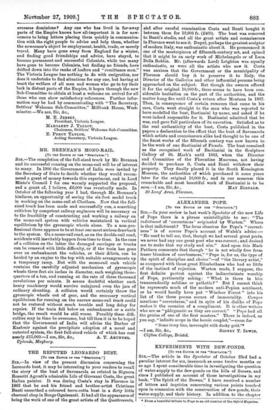THE REPUTED LEONARDO BUST.
pro TIEN EDITOR OF THE "SPECTATOR."] SIR,—In view of the present discussion concerning the Leonardo bust, it may be interesting to your readers to recall the story of the bust of Savonarola as related in Signora Rossetti Agresti's admirable Life of Giovanni Costa, the great Italian painter. It was during Costa's stay in Florence in 1863 that he and his friend and brother-artist Cristiano Banti unearthed a coloured terra-cotta bust in a dirty little charcoal shop in Borgo Ognissauti. It had all the appearance of being the work of one of the great artists of the Quattrocento,
and after careful examination Costa and Banti bought it between them for 10,000 fr. (£400). The bust was removed to Banti's studio, and all the great artists and connoisseurs in Florence went to see it Dupre, perhaps the greatest sculptor of modern Italy, was enthusiastic about it. He pronounced it one of the masterpieces of fifteenth-century art, and opined that it might be an early work of Michelangelo or of Luca Della Robbia. Mr. (afterwards Lord) Leighton was equally enthusiastic, as were all the artists who saw it. Costa was anxious that the Government or the municipality of Florence should buy it to preserve it to Italy, the Director of the Galleries and other influential persons being approached on the subject. But though the owners offered it for the original 10,000 fr., there seems to have been con- siderable hesitation on the part of the authorities, and the matter hung fire until Costa's return after Mentana in 1867. Then, in consequence of certain rumours that came to his ears, Costa went straight to the man who was reported to have modelled the bust, Bastianini by name, and asked if he were indeed responsible for it. Bastianini admitted that he was, and gave full particulars of its execution. Satisfied as to the real authenticity of the bust, Costa published in the papers a declaration to the effect that the bust of Savonarola which artists and connoisseurs alike had thought to be one of the finest works of the fifteenth century was now known to be the work of one Bastianini of Fiesole. The bust remained as the recognised work of Bastianini in the Sculpture Gallery of St. Mark's until 1883, when the Director and Committee of the Florentine Museums, not having decided to purchase it, Costa and Banti withdrew their property. They finally placed it in the South Kensington Museum, the authorities of which purchased it some years later for the original 10,000 fr., and in our museum this remarkable and most beautiful work of Bastianini is to be














































 Previous page
Previous page